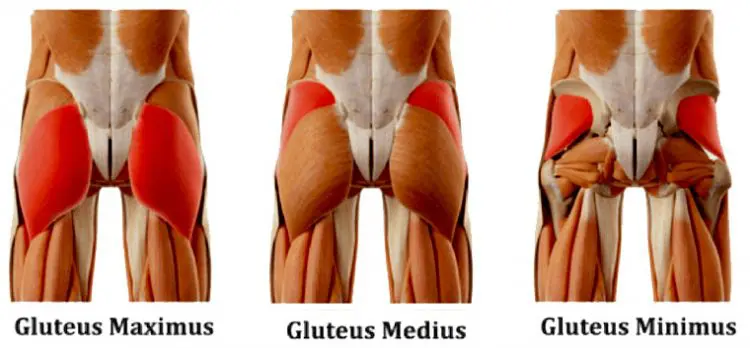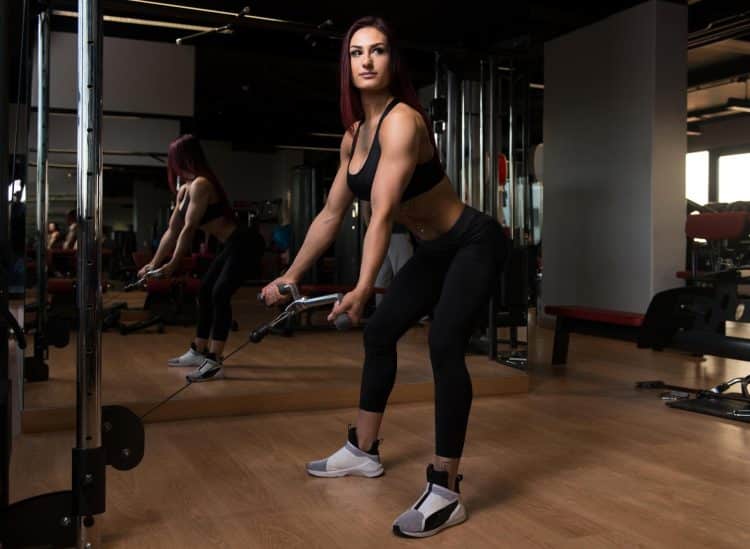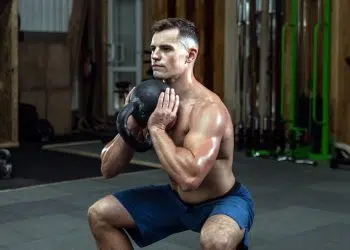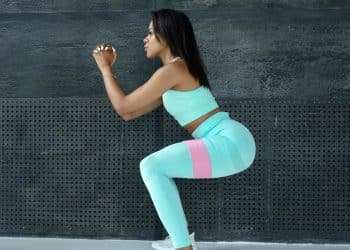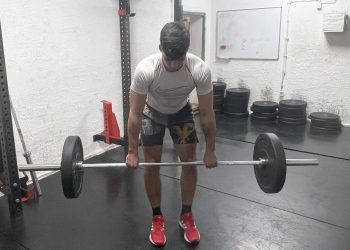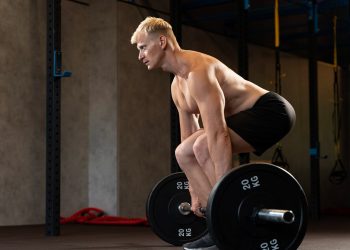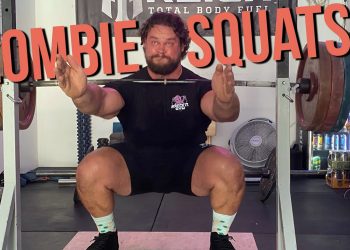You are currently sitting on arguably the most important muscle in your body – the gluteus maximus. Known as the glutes for short, and basically your butt, the glutes are your primary hip extender.
Weak glutes can destabilize your hips and even affect your lower back. When bending and lifting, if your glutes are weak, your lower back may have to take up the slack and work harder than necessary. This puts extra stress on your lumbar spine and the muscles in that region.
Strengthening your glutes can help save your lower back from strain and injury.
To the side of your gluteus maximus, you’ll find two more gluteal muscles – the minimus and medius. While smaller than the gluteus maximus, these muscles are no less important.
Gluteus minimus and medius abduct your hip, meaning they lift your legs out and away from the midline of your body. They’re also involved in external hip rotation. As such, these muscles help stabilize your hips and prevent your knees from dropping or turning inward when you walk, run, jump, lunge, or squat.
So, the three gluteal muscles are crucial for performance and joint health. Still, many people are more interested in glute aesthetics. Building a firm, shapely but is a popular training goal for women AND men.
Level Up Your Fitness: Join our 💪 strong community in Fitness Volt Newsletter. Get daily inspiration, expert-backed workouts, nutrition tips, the latest in strength sports, and the support you need to reach your goals. Subscribe for free!
The good news is that function and aesthetics do not have to be opposing goals, and with the right choice of exercises, you can build a butt that looks good and works well, too.
In this article, we reveal the best cable glute exercises and provide you with some great workouts to try.
Why Use Cables, Anyway?
While there is nothing wrong with training your glutes with freeweights and bodyweight exercises, cable machines offer several notable advantages and may even provide better workout results for some people.
Reasons to include cable exercises in your glute workouts include:
Constant tension
Most freeweight and bodyweight exercises have uneven strength curves, meaning the load varies throughout the movement. The strength demand changes and may even drop off entirely during each rep.
Needless to say, this is not the best way to develop rock-hard glutes.
Cable machines tend to keep your muscles under constant tension, with no drop-off in load during each rep. This is useful for improving your mind-muscle connection, improving muscle engagement, and making your workouts more efficient.
A large range of motion
Cable exercises often allow for a greater range of motion than their freeweight or bodyweight equivalents. For example, during standing hip extensions, you can start each rep with your leg flexed in front of you, giving you a movement of about 100-120 degrees.
This stretch-to-contract action will build flexibility and mobility as well as strength. Also, exercises that use a big range of motion are generally more challenging and functional than those that involve less movement.
Work the angles
Cables allow you to hit your muscles from an almost infinite number of angles. You can change the position of your leg or body to preferentially hit all the parts of your glutes and make your workouts are varied as possible. Even small changes can yield noticeable differences in how an exercise feels.
Minimal stress on the spine
Most cable exercises are very spine-friendly. With no heavy barbells on your shoulders or dumbbells in your hands, there is no spinal compression and very little shearing force on the lower back. So, suppose barbell exercises like Romanian deadlifts and hip thrusts bother your lower back. In that case, you’ll probably find most glute cable exercises far less stressful.
Very safe
Training to failure with freeweights can be risky, especially if you lift without a spotter or use heavy weights. There is no such risk with most cable exercises. In fact, other than the weights clashing together, there should be no issue with taking your glute training sets right up to failure and even beyond…
To failure – and beyond!
Cable exercises are perfect for intensity-boosting, muscle-building drop sets that train your muscles beyond failure.
To do a drop set, rep out as usual and then, as you hit failure, reduce the weight by 10-15% and then rep out again. Repeat this process a couple of times to completely exhaust the target muscles.
Read more about drop sets here.
The Best Cable Glute Exercises
There is nothing worse than training but not getting the results you want. Choosing the wrong exercises can lead to ineffective workouts. So, if you want to build a strong, functional set of glutes with cables, these are the exercises you should use!
- Cable goblet squat
- Stiff-legged cable deadlift
- Cable pull-through
- Cable Zercher squat
- Cable lunge
- Cable glute walk
- Cable glute extensions
- Cable hip abductions
- Cable kneeling hip thrust
1. Cable goblet squat
Goblet squats are a popular leg exercise that works the entire lower body. However, using a cable increases glute activation because you’ll have to work harder to keep your torso upright. Make sure you descend until your hips are level with your knees to hit your glutes as hard as possible. The deeper you squat, the more work your glutes must do.
How to do it:
- Attach a rope handle or straight bar to a low pulley. Hold your chosen handle in front of your chest and just under your chin. Pull your shoulders down and back, and brace your core.
- Take a small step backward and stand with your feet about shoulder-width apart, toes turned slightly outward.
- Bend your knees and squat down until your thighs are at least parallel to the floor. Do not round your lower back.
- Stand back up and repeat.
Pro tip: Increase glute minimus and medius engagement by putting a booty band around your knees and pushing your legs outward.
2. Stiff-legged cable deadlift
The barbell stiff-legged deadlift is a great glute exercise, but it can be problematic for some exercisers as it can be hard on the lower back. Also, tension tends to diminish as you near the top of each rep. The cable variation is more lower-back friendly, and there is a more constant load on the glutes.
How to do it:
- Attach a bar or rope handle to a low pulley. Then, grab the handle, stand up, and take 1-2 steps back to tension the cable.
- Stand with your feet between shoulder and hip-width apart, knees slightly bent. Brace your core and pull your shoulders down and back.
- Push your butt back and hinge forward from your hips, extending your arms out in front of you. Do not round your lower back.
- Drive your hips forward and stand back up, tensing your glutes as you do so.
- Repeat for the desired number of repetitions.
Top tip: You can also do this exercise on one leg, i.e., a single-leg stiff-legged deadlift. This increases the balance demand of the exercise, which, in turn, dials up glute engagement.
3. Cable pull-through
Cable pull-throughs are a powerful hip extension exercise favored by powerlifters looking to boost their barbell squat and deadlift performance. This lower-back-friendly exercise is an excellent alternative to Romanian deadlifts and other freeweight hip hinge exercises.
How to do it:
- Attach a rope handle to a low pulley machine. Stand with your back to the weight stack, feet astride the handle.
- With your abs braced and shoulders down and back, bend down and grab the handle with both hands. Stand up and take a couple of steps forward to tension the cable.
- Stand with your feet shoulder-width apart, knees slightly bent, hands in front of your hips. This is your starting position.
- Push your hips back and lean forward until you feel a deep stretch in your hamstrings. Keep going until your hands travel behind your knees. Do not allow your back to round. Maintain a neutral spine throughout, including your upper back and neck.
- Drive your hips forward and stand back up.
- Hinge forward again and repeat.
Pro tip: Push your hips forward into full extension and tense your glutes as hard as you can at the top of each rep to maximize muscle recruitment.
4. Cable Zercher squat
You probably won’t see many people doing this exercise, which is a shame because it’s an excellent move for building a better butt. Like cable goblet squats, it works your entire lower body. Still, because the weight is trying to pull you forward, you’ll need to switch on your glutes more to maintain an upright posture.
How to do it:
- Attach a straight or EZ bar to a low cable machine. Hold the handle in the crooks of your elbows. Pad the bar with a towel if necessary.
- Take a small step backward and stand with your feet about shoulder-width apart, toes turned slightly outward.
- Bend your knees and squat down until your thighs are roughly parallel to the floor. Do not round your lower back.
- Stand back up and repeat.
Pro tip: Increase glute minimus and medius engagement by putting a booty band around your knees and pushing your legs outward.
5. Cable lunge
Lunges are a fantastic lower body exercise that hits your glutes particularly well. Using a cable machine increases glute engagement. The weight pulls you forward, and you’ll need to use your glutes more to decelerate your descent and power you through your ascent.
How to do it:
- Attach a D-shaped handle or rope handle to a low pulley. Hold it with both hands and then take 1-2 steps back to tension the cable. Stand up tall, brace your abs, and pull your shoulders down and back.
- Take a large step forward, bend your legs, and lower your rearmost knee down to within an inch of the floor.
- Push off your front leg and return to the starting position.
- Do your next rep with the same leg or alternate sides as preferred.
Pro tip: Try reverse cable lunges off a step to make this already great exercise even more glute-centric.
6. Cable glute walk
This challenging exercise works your glutes isometrically or statically. Shifting your weight from one leg to another while maintaining a squat ensures all glute muscles get a good workout. Keeping your muscles under constant tension will create deep fatigue and an intense burn not just in your gluteal muscles but in your quadriceps and hamstrings, too. Don’t go too heavy too soon with this exercise; it’s a lot harder than it looks!
How to do it:
- Attach a rope handle or straight bar handle to a low pulley.
- Grab the handle, extend your arms, and walk back 1-2 steps.
- Get into a squat position with your thighs roughly parallel to the floor and your torso upright. Do not round your lower back. Brace your core and pull your shoulders down and back.
- Maintaining the squat position, take 5-6 small steps backward followed by 5-6 steps forward.
- Keep your weight on your heels for maximum glute engagement. Make sure that your knees don’t collapse inwards.
- One trip forward and backward is one rep, so keep going!
Pro tip: Fire up your glutes even more by wearing a booty band around your knees.
7. Cable glute extensions
Exercises 1-6 are compound exercises, meaning they involve multiple joints and muscles. All your glutes are engaged, but they’re working with your quads and hamstrings. Starting with glute cable kickbacks, the following exercises isolate your glutes so you can focus all of your attention on a smaller area.
Level Up Your Fitness: Join our 💪 strong community in Fitness Volt Newsletter. Get daily inspiration, expert-backed workouts, nutrition tips, the latest in strength sports, and the support you need to reach your goals. Subscribe for free!
How to do it:
- Set the pulley to the lowest setting and attach a cuff to the cable. Put the cuff around your ankle.
- Take a step back from the machine so that the weight is engaged. Hinge at the hips and hold onto the pulley machine for support.
- Brace your core and kick your leg back as far as possible while keeping your legs straight.
- Pause and contract your glutes at the top.
- Slowly return to the starting position.
- Repeat for recommended reps before switching sides.
Pro tip: No ankle cuff? No problem! Take a loop-type resistance band and wrap it around your ankles. Then, clip the two ends to your low cable, and you’re good to go!
8. Cable hip abductions
In anatomical terms, abduction means to take away from the midline of the body. This movement involves the gluteus minimus and medius more than the maximus. Cable machine hip abductions are arguably the most effective way to target these muscles with enough weight to strengthen them and make them grow.
How to do it:
- Set the pulley to the lowest setting and attach a cuff to the cable. Put the cuff around your ankle.
- Standing sideways onto the machine, take one step away so the cable crosses in front of your other foot.
- Raise your leg up and out to the side. Do not twist your hips or shoulders.
- Lower your leg and repeat.
Pro tip: Increase the range of motion by not just bringing your exercising leg down but crossing it in front of your supporting leg.
9. Cable kneeling hip thrust
Barbell hip thrusts are a widely-performed glute exercise. However, they can be uncomfortable, and the tension leaves your muscles as you lower your hips to the floor. The cable version is more comfortable, and the stress on the glutes is constant.
How to do it:
- Attach a dipping belt to a low cable machine. Put the belt on so the wide part is across your hips. Kneel down with your back to the pulley machine.
- Sit back into your heels and then drive your hips forward and kneel upright. Extend your hips but take care not to hyperextend your lower back.
- Sit back again and repeat.
Pro tip: Kneel on a folded mat or foam pad for comfort. Grip a chair or exercise bench for support if necessary.
Cable Glute Workouts
While you could just pick and choose a few of these exercises and add them to your training, you’ll get better results if you follow a more structured plan. So, here are three cable-based glute workouts that will help you build a stronger, better-looking butt.
Pick one workout, do it for a few weeks, and then progress to the next one, or alternate through the workouts every time you train as preferred.
But, before you start any workout, make sure you prepare your muscles and joints with an appropriate warm-up. Begin with 5-10 minutes of easy cardio followed by some mobility and flexibility exercises for your knees, hips, and lower back.
Finish off your warm-up with a couple of 10-second sets of table bridges to really wake up your glutes and improve muscle contractility.
Read more about warming up for strength training here.
Workout 1 – Pre-exhaust glute blaster
This workout combines cable glute isolation exercises with compound exercises to fully fatigue your gluteal muscles.
Exercises are paired into supersets, which are designated a) and b) in the program. Do exercise a) and then, without resting, do exercise b). Rest a moment, and then repeat the pairing.
| # | Exercise | Sets | Reps | Recovery |
| 1a | Kneeling cable hip thrust | 2-4 | 12-20 | 60-90 seconds |
| 1b | Cable goblet squat | |||
| 2a | Cable hip abductions (L & R) | 2-4 | 12-20 | 60-90 seconds |
| 2b | Cable glute walk | |||
| 3a | Cable hip extension (L & R) | 2-4 | 12-20 | 60-90 seconds |
| 3b | Cable pull through |
Workout 2 – Compound all the way
The great thing about compound exercises is that they’re more time efficient and functional than most isolation exercises. They also tend to burn more calories as they involve more muscles. This three-exercise workout is short and sweet but will ensure you work your legs and glutes plenty hard enough to get good results in less time.
| # | Exercise | Sets | Reps | Recovery |
| 1 | Cable Zercher squats | 3-5 | 12-20 | 60-90 seconds |
| 2 | Cable stiff-legged deadlift | 3-5 | 12-20 | 60-90 seconds |
| 3 | Cable lunge (L & R) | 3-5 | 12-20 | 60-90 seconds |
Workout 3 – Isolate to annihilate
Isolation exercises let you focus on your muscles with laser-like precision. This workout is for anyone who wants to hit their glutes without involving their hamstrings or quadriceps too much.
| # | Exercise | Sets | Reps | Recovery |
| 1 | Cable hip abductions | 2-4 | 12-20 | 60-90 seconds |
| 2 | Cable glute extensions | 2-4 | 12-20 | 60-90 seconds |
| 3 | Cable kneeling hip thrust | 2-4 | 12-20 | 60-90 seconds |
| 4 | Cable glute walk | 2-4 | 12-20 | 60-90 seconds |
Read also: 20 Best Butts on the Internet
Cable Glute Workouts FAQs
1. How much weight should I use for each exercise?
Unfortunately, this is not an easy question to answer because I don’t know how strong you are! So, pick a weight that takes you to within a couple of reps of failure somewhere in the prescribed rep range of 12-20 reps. If you can’t do at least 12, the weight is too heavy, but if you can do more than 20 reps, the weight is too light.
Once you’ve found the right weight, make a note of it and do your best to either increase the load or do more reps as you get stronger.
2. Can I change the exercises?
Yes, indeed! But try to use similar movements. For example, if you don’t like cable stiff-legged deadlifts, you can do something like kettlebell swings or cable pull-throughs instead.
However, doing leg curls instead of stiff-legged deadlifts would not be a good swap.
3. Can I train my glutes every day?
You CAN train your glutes every day, providing you keep the volume low and don’t go too close to failure. That way, you’ll still be able to recover between workouts. This is the essence of high-frequency, low-volume strength training. However, 2-3 glute workouts per week should be sufficient for most people.
4. Can I still do freeweight and bodyweight glute exercises?
Of course! While cables are a great training tool for working your glutes, there is nothing wrong with freeweight and bodyweight exercises. Instead, use all the options available to keep your workouts varied and interesting.
5. How soon until my glutes start to get stronger and bigger?
You should start to see changes in as few as four weeks of consistent training, i.e., hitting your glutes 2-3 times a week and not skipping any workouts. Combine your training with a healthy, sustainable diet, and get plenty of sleep, and you may even see results sooner!
6. What’s the best range of motion for cable glute exercises?
Range of motion varies from exercise to exercise and also depends on your flexibility and mobility. For example, some people can use a large range of motion, e.g., 90 degrees or more of hip flexion, during cable stiff-legged deadlifts. In comparison, less flexible people may be limited to 50-60 degrees.
The key to safe exercise performance is using a comfortable range of motion that doesn’t force you to modify your form by causing other joints to move.
Again, with the cable stiff-legged deadlift, you can increase your angle of motion by rounding your lower back, but this does nothing for your glutes and only increases your risk of injury.
So, use the biggest range of motion you can, but make sure the movement is only coming from the joint/muscles you are training, and not elsewhere.
7. How does the mind-muscle connection come into cable glute exercises?
If you cannot feel a muscle working, you probably won’t be able to fully develop it. The mind-muscle connection means mentally focusing on the body part you are training so you can really feel it working. Not just when lactic acid starts to build up and it begins to burn, but during each and every rep up to that point.
Practice tensing/contracting your glutes even when you aren’t training, and you should find that, when it’s time to work out, your cable glute exercises are much more effective.
8. Can you do heavy weights and low reps with cable glute exercises?
Unlike exercises like barbell deadlifts and squats, cable glute exercises are not ideal for low rep, heavy weight training. In many cases, the weight will pull you off your feet and make the exercise impossible to do correctly.
Instead, most glute-building cable exercises work best with light to moderate weights and medium to high reps. If you want to go hard and heavy, barbells are probably your best option.
9. How should I position my feet during cable glute exercises?
In general, your feet should point the same direction as your knees. This ensures there is no rotational stress on your knee joints, which could cause injuries.
With squatting-type exercises, you can have your feet parallel or, if you prefer, turn your toes slightly outward. The wider your stance, the more likely you are to need to turn your feet out slightly.
For single leg exercises, your supporting foot should point straight ahead.
However, it’s important to note that the angle of your feet is not as important as the angle of your hips. If you turn your hips outward or inward, your feet should follow.
Wrapping Up
Don’t think for a moment we’re telling you to give up squats and deadlifts; that would be sacrilegious! However, if you want to develop a firm, muscular butt, supplementing your free-weight leg workouts with some cable exercises should help.
Using cables means you can train hard without overloading your spine and target the individual glutes more precisely for optimal balance and function. Using cables will also add some variety to your workouts, and variety is critical for avoiding training plateaus.
Of course, you could go all cables, all the time, especially if you need a break from heavy barbells.
Try our cable-only leg glute workouts to experience the transformative power of these exercises for yourself.

